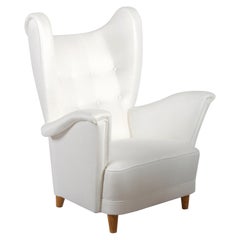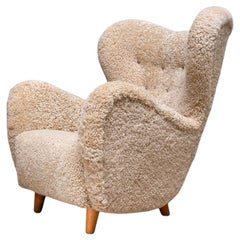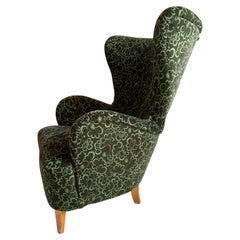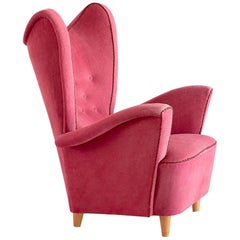Otto Schulz Wingback Armchair
Vintage 1940s Danish Scandinavian Modern Wingback Chairs
Elm, Upholstery
Vintage 1940s Swedish Scandinavian Modern Armchairs
Sheepskin, Birch
Recent Sales
Mid-20th Century Swedish Mid-Century Modern Armchairs
Fabric, Birch
Vintage 1940s Swedish Scandinavian Modern Armchairs
Velvet, Wood, Elm, Fabric, Wool, Upholstery
Vintage 1940s Swedish Scandinavian Modern Armchairs
Fabric, Mohair, Velvet, Beech
Vintage 1940s Swedish Scandinavian Modern Armchairs
Fabric, Wool, Mohair, Upholstery, Beech
People Also Browsed
Vintage 1930s Czech Art Deco Lounge Chairs
Beech, Sheepskin
Vintage 1930s Swedish Art Deco Sofas
Velvet, Birch
2010s British Scandinavian Modern Ottomans and Poufs
Velvet, Mohair, Oak
2010s South African Minimalist Night Stands
Wood
2010s Italian Modern Chandeliers and Pendants
Metal, Brass
Mid-20th Century Italian Mid-Century Modern Lounge Chairs
Brass
2010s Table Lamps
Iron
2010s Danish Scandinavian Modern Dining Room Chairs
Oak
2010s American Modern Stools
Wood, Oak
21st Century and Contemporary American Bohemian Chandeliers and Pendants
Brass
Vintage 1940s European Scandinavian Modern Club Chairs
Sheepskin, Beech
Early 20th Century Danish Art Deco Lounge Chairs
Wool, Walnut
Vintage 1960s German Mid-Century Modern Sectional Sofas
Mohair, Foam, Wood
Vintage 1960s French Mid-Century Modern Lounge Chairs
Fabric, Oak
Vintage 1950s Swedish Scandinavian Modern Sofas
Wool, Cotton, Beech
2010s Belgian Modern Club Chairs
Linen
Otto Schulz for sale on 1stDibs
Throughout his career as an interior and furniture designer, publisher and founder of the Swedish furniture company Boet, Otto Schultz was a key figure in promoting mid-century modern Scandinavian design.
Born in Germany in 1882, Schultz moved to Sweden in 1907, where he became interested in designing furniture and interiors. In 1920, Schultz founded his furniture company Boet in Gothenburg, where he created functional and traditional designs featuring quintessential elements of Scandinavian furnishings. Around the same time, Schultz started the design and living magazine Boet, which published articles and profiles highlighting Sweden’s most influential architects and designers. He served as Boet’s publisher and editor until 1938.
During the 1930s, Schultz created a range of opulent Scandinavian modern and neoclassical furniture, including cabinets, secretaires and side tables, using fine woods like elm, birch, mahogany and walnut. Many of his pieces showcased his patented use of decorative nails called Bopoint.
He was best known for the Schultz lounge chair, which he designed in 1936. Its voluptuous design featured a generous seat and a large, curved backrest and it was upholstered with a luxurious blend of alpaca and wool. The Schultz chair was highly popular in Sweden in the 1940s. While Boet originally produced it, Swedish furniture manufacturer Jio Möbler took over its production in 1941.
Schultz operated Boet until his retirement in 1950. He died in 1970. Today, Schultz’s pieces are favorites among interior designers and collectors seeking a mix of modern Scandinavian simplicity and lavish decorative style.
On 1stDibs, discover vintage Otto Schultz seating, storage cabinets and case pieces, tables and more.
A Close Look at Scandinavian-modern Furniture
Scandinavian modernism is perhaps the warmest and most organic iteration of modernist design. The work of the designers associated with vintage Scandinavian modern furniture was founded on centuries-old beliefs in both quality craftsmanship and the ideal that beauty should enhance even the humblest accessories of daily life.
ORIGINS OF SCANDINAVIAN MODERN FURNITURE DESIGN
- Emerged in the 1930s
- Scandinavian design and Nordic design originated primarily in Denmark, Sweden, Finland, Iceland and Norway
- Introduced in the United States in mid-20th century
- Informed by the Bauhaus; influenced American mid-century modernism
CHARACTERISTICS OF SCANDINAVIAN MODERN FURNITURE DESIGN
- Bold, clean lines and simple, sturdy symmetries
- Use of natural materials — native woods such as pine, ash and beech
- Open, airy spaces
- Promotion of functionality
- Emphasis on craftsmanship; rooted in cabinetry profession and traditional construction techniques
- Minimal ornamentation (little to no embellishment)
- A neutral or light color palette owing to prominence of light woods
SCANDINAVIAN MODERN FURNITURE DESIGNERS TO KNOW
- Alvar Aalto
- Hans Wegner
- Kaare Klint
- Arne Jacobsen
- Greta Magnusson Grossman
- Finn Juhl
- Arne Vodder
- Verner Panton
ICONIC SCANDINAVIAN MODERN FURNITURE DESIGNS
VINTAGE SCANDINAVIAN MODERN FURNITURE ON 1STDIBS
The gentle, organic contours that are typical of Scandinavian design appear in the furnishings and decor created by Danish, Finnish and Swedish designers not as a stylistic gesture, but rather as a practical, ergonomic — and, as importantly, elegant — response to the human form.
Each nation produced exceptional talents in all areas of the applied arts, yet each had its forté. Sweden was home to Greta Magnusson Grossman and Bruno Mathsson — creators of the classic Grasshopper lighting series and Berlin daybed, respectively — but the country excelled most notably at ceramics. In the 1920s at the great Gustavsberg porcelain manufactory, Wilhelm Kåge introduced pieces in the Scandinavian style based on influences from folklore to Cubism; his skills were passed on to his versatile and inspired pupils Berndt Friberg and Stig Lindberg.
Likewise, Finland produced a truly ingenious Scandinavian modern furniture designer in the architect Alvar Aalto, a master at melding function and artistic form in works like the Paimio chair, created in collaboration with his first wife, Aino. Yet Finnish glassware was pre-eminent, crafted in expressive, sculptural designs by Tapio Wirkkala and Timo Sarpaneva.
The Danes excelled at chairs. Hans Wegner and Arne Jacobsen were exemplars of the country’s facility with wood, particularly teak.
Wegner created such iconic pieces as the Round chair and the Wishbone chair; Jacobsen — while the revolutionary architect and furniture innovator produced the best-selling plywood Ant chair — designed two classic upholstered pieces of the 1950s: the Swan chair and Egg chair. The list of great Danes could go on and on, including Finn Juhl, a stylistic maverick and maker of the bold Chieftain chair; Poul Kjaerholm, with his lean metal-and-rattan aesthetic; and Verner Panton, who introduced a vibrant Pop note into international design.
Today, decades after their heyday, the prolific, ever-evolving Scandinavian modernists continue to amaze and delight, and interior designers all over the world use their pieces to bring warmth to any given space.
On 1stDibs, you will note both instantly recognizable vintage Scandinavian modern chairs, sofas, rugs and tables — those that have earned iconic status over time — and many new discoveries.
Finding the Right Armchairs for You
Armchairs have run the gamut from prestige to ease and everything in between, and everyone has an antique or vintage armchair that they love.
Long before industrial mass production democratized seating, armchairs conveyed status and power.
In ancient Egypt, the commoners took stools, while in early Greece, ceremonial chairs of carved marble were designated for nobility. But the high-backed early thrones of yore, elevated and ornate, were merely grandiose iterations of today’s armchairs.
Modern-day armchairs, built with functionality and comfort in mind, are now central to tasks throughout your home. Formal dining armchairs support your guests at a table for a cheery feast, a good drafting chair with a deep seat is parked in front of an easel where you create art and, elsewhere, an ergonomic wonder of sorts positions you at the desk for your 9 to 5.
When placed under just the right lamp where you can lounge comfortably, both elbows resting on the padded supports on each side of you, an upholstered armchair — or a rattan armchair for your light-suffused sunroom — can be the sanctuary where you’ll read for hours.
If you’re in the mood for company, your velvet chesterfield armchair is a place to relax and be part of the conversation that swirls around you. Maybe the dialogue is about the beloved Papa Bear chair, a mid-century modern masterpiece from Danish carpenter and furniture maker Hans Wegner, and the wingback’s strong association with the concept of cozying up by the fireplace, which we can trace back to its origins in 1600s-era England, when the seat’s distinctive arm protrusions protected the sitter from the heat of the period’s large fireplaces.
If the fireside armchair chat involves spirited comparisons, your companions will likely probe the merits of antique and vintage armchairs such as Queen Anne armchairs, Victorian armchairs or even Louis XVI armchairs, as well as the pros and cons of restoration versus conservation.
Everyone seems to have a favorite armchair and most people will be all too willing to talk about their beloved design. Whether that’s the unique Favela chair by Brazilian sibling furniture designers Fernando and Humberto Campana, who repurposed everyday objects to provocative effect; or Marcel Breuer’s futuristic tubular metal Wassily lounge chair; the functionality-first LC series from Charlotte Perriand, Le Corbusier and Pierre Jeanneret; or the Eames lounge chair of the mid-1950s created by Charles and Ray Eames, there is an iconic armchair for everyone and every purpose. Find yours on 1stDibs right now.



